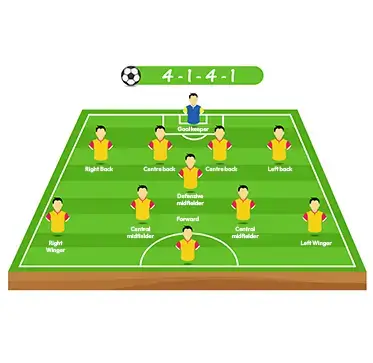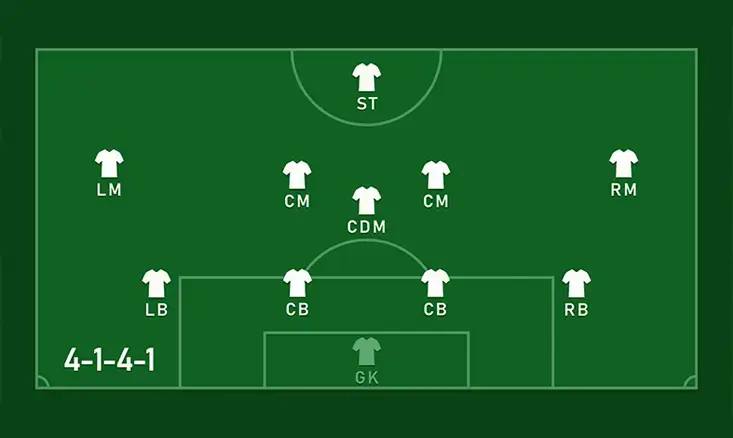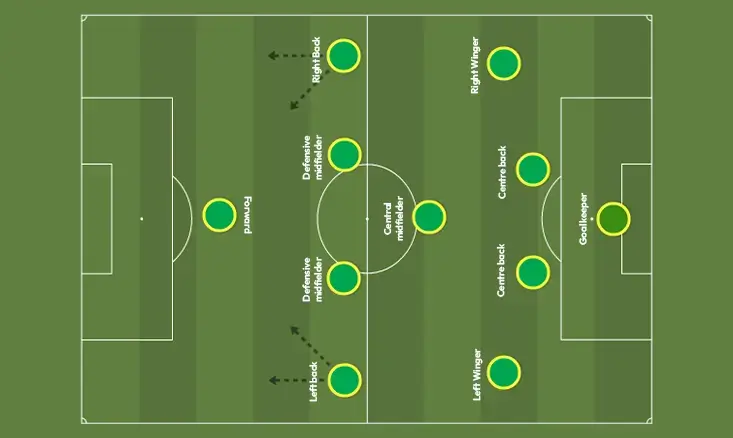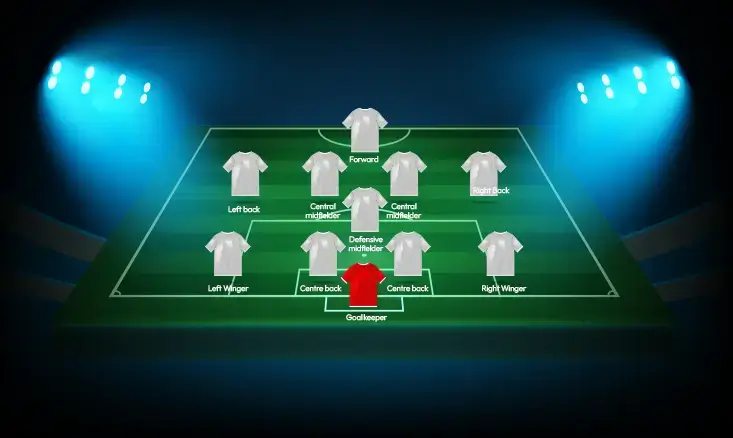Youth Soccer 4-1-4-1 Formation Guide

CRFC BLOGS
LATEST BLOGS & NEWSLETTERS
Youth Soccer 4-1-4-1 Formation Guide
When coaching youth soccer players, selecting the correct formation is crucial for developing players’ skills, understanding of the game, and team dynamics. The Youth Soccer 4-1-4-1 formation stands out as a balanced and strategic approach among the various formations available. This formation emphasizes defensive stability and provides opportunities for effective counter-attacking play. This guide explores everything you need to know about the 4-1-4-1 formation, including its numbers, tactics, positions, and how it compares to other famous formations.
Youth Soccer 4-1-4-1 Formation
The Youth Soccer 4-1-4-1 formation is a versatile soccer system consisting of four defenders, one defensive midfielder, four midfielders, and one striker. It is designed to provide a balance between defense and attack. The 4-1-4-1 formation is particularly effective in youth soccer because it teaches young players the importance of positioning, teamwork, and tactical discipline.
At its core, the 4-1-4-1 formation focuses on defensive solidity while allowing quick transitions to offense. This makes it an ideal choice for coaches who want to instill a solid defensive mindset in their players while encouraging them to take advantage of counter-attacking opportunities.
The Youth Soccer 4-1-4-1 Formation Structure
The Youth Soccer 4-1-4-1 formation structure breaks down as follows:
4 Defenders
The four defenders consist of two center-backs and two fullbacks. The center backs are responsible for staying central, marking the opposition’s forwards, and intercepting attacks. The fullbacks primarily focus on defending against wide threats, but they also have the flexibility to push forward and support the attack when necessary.
1 Defensive Midfielder
The defensive midfielder is a crucial player in the 4-1-4-1 formation. Positioned just in front of the defense, this player breaks up opposition plays, provides cover for the defenders, and links the play between the defense and midfield. The defensive midfielder must be disciplined, strong in tackling, and capable of reading the game well.
4 Midfielders
The midfielders in the 4-1-4-1 formation include two central midfielders and two wide midfielders. The central midfielders help control the game’s tempo, distribute the ball, and support defense and attack. The wide midfielders provide width to the team’s play, supporting the striker and helping defensively when needed.
1 Striker
The striker in the 4-1-4-1 formation is responsible for leading the attack. This player must be versatile, capable of holding up the ball to allow teammates to join the attack, and clinical in front of the goal. The striker is crucial in converting the team’s counter-attacking opportunities into goals.

Youth Soccer 4-1-4-1 Formation Positional Roles
The Youth Soccer 4-1-4-1 formation is all about balance. It allows teams to defend in numbers while still being able to move forward with purpose when they have the ball. The formation can be adapted to suit different play styles, depending on whether a team wants to focus more on defending or attacking.
Defensive Midfielder
The defensive midfielder’s primary role is to protect the back four by intercepting passes, making tackles, and covering any spaces left by the defenders. The defensive midfielder also acts as a bridge between the defense and the attack, linking play and ensuring that the team can transition smoothly from defense to offense.
Wide Midfielders
The wide midfielders in the 4-1-4-1 formation provide width to the team’s play. They must be able to contribute defensively by tracking back and helping the full-backs, but they also need to push forward and support the striker during attacks. This dual responsibility requires excellent stamina and tactical awareness.
Striker
The striker in the 4-1-4-1 formation is the team’s primary goal scorer. However, the striker must also be capable of holding up the ball and bringing other players into the attack. This requires reasonable ball control, strength, and an understanding of how to create space for teammates.
Youth Soccer 4-1-4-1 Formation Tactics
The success of the Youth Soccer 4-1-4-1 formation relies heavily on its tactics, which are centered around maintaining a compact defensive shape and being ready to counter-attack swiftly.
Defensive Strategy
Compact Shape
One of the main strengths of the 4-1-4-1 formation is its ability to maintain a compact shape. The four defenders and the defensive midfielder work closely together to close down space, making it difficult for the opposition to penetrate the defense. This compact shape is essential for limiting the number of scoring opportunities the opposition can create.
Low Block Defense
Teams using the 4-1-4-1 formation often employ a low block defense, where the defensive line stays deep, and the team absorbs pressure from the opposition. This tactic is particularly effective against more vigorous opponents, forcing them to break down a well-organized defense.
Offensive Strategy
Counter-Attacking Play
The 4-1-4-1 formation is well-suited to counter-attacking soccer. Once the team regains possession, the wide midfielders and the striker can quickly transition from defense to attack. The defensive midfielder is crucial in initiating these counter-attacks by rapidly distributing the ball to the more advanced players.
Support Play
While the formation can sometimes appear defensive, the midfielders are encouraged to push forward and support the striker during attacks. The wide midfielders stretch the play, while the central midfielders provide options for passing and shooting from distance. This support play ensures that the team can still be a threat going forward, even with just one striker.

How to Play Youth Soccer 4-1-4-1 Formation
So, how can Youth Soccer players effectively play the 4-1-4-1 formation? It starts with understanding the formation’s defensive principles and then building on that foundation to create attacking opportunities.
Training Focus
Defensive Drills
To play the 4-1-4-1 formation effectively, it is important to start with defensive drills that emphasize maintaining shape, positioning, and communication. Players must understand how to work together to cover spaces, close down the opposition, and prevent goal-scoring opportunities.
Transition Drills
Quick transitions from defense to attack are a vital component of the 4-1-4-1 formation. Coaches should focus on drills that train players to move the ball quickly from the back to the front, utilizing the wide midfielders and strikers to create counter-attacking opportunities.
Positional Discipline
Players must understand their roles and responsibilities within the formation. Coaches should emphasize the importance of staying in position, communicating with teammates, and maintaining the team’s shape on defense and offense.
Game Implementation
Starting with Defense
The foundation of the 4-1-4-1 formation is a strong defense. Coaches should ensure that the team understands how to defend effectively as a unit, with each player knowing their role in the defensive structure.
Building Attacks
Once the defensive principles are in place, the team can focus on building attacks. This involves encouraging the midfielders to support the striker, creating overlaps with the full-backs, and using the wide midfielders to stretch the play and create space for the striker.
Comparing and Contrasting with Other Formations
While the Youth Soccer 4-1-4-1 formation is highly effective, it’s also important to consider how it compares to other formations, such as the 4-4-2, 4-3-3, and 4-2-3-1.
- 4-4-2 Formation
The youth soccer 4-4-2 formation is one of soccer’s most traditional and widely used formations. It features two banks of four players with two strikers upfront. The 4-4-2 is more accessible for young players to understand and provides a solid balance between defense and attack. However, it needs more defensive solidity provided by the extra midfielder in the 4-1-4-1 formation, making it more vulnerable to teams that play through the middle.
- 4-3-3 Formation
The youth soccer 4-3-3 formation is more attack-oriented, with three forwards leading the line. This formation is great for teams with solid offensive players who can take advantage of the extra attacking option. However, it can expose the defense, especially if the midfielders aren’t disciplined enough to cover for the advanced forwards. Compared to the 4-1-4-1, the 4-3-3 sacrifices some defensive stability for more significant attacking potential.
- 4-2-3-1 Formation
The youth soccer 4-2-3-1 formation is similar to the 4-1-4-1 but with an additional attacking midfielder playing behind the striker. This formation provides a good balance between defense and attack, with the two defensive midfielders offering protection for the back four. However, the 4-1-4-1 formation is more defensively solid, emphasizing maintaining a compact shape and controlling the midfield.
Each formation has its strengths and weaknesses, but the Youth Soccer 4-1-4-1 formation is particularly effective for teams looking to build a solid defensive foundation while maintaining the ability to counter-attack. It’s a versatile formation that can be adapted to suit different play styles and is especially useful for teaching young players the importance of positional discipline and teamwork.

Conclusion
The Youth Soccer 4-1-4-1 formation is a versatile and balanced system that can help young players develop their defensive and offensive skills. By understanding the formation’s numbers, tactics, and positions, coaches can better prepare their teams for success on the field. Whether used as a primary strategy or as a variation against different opponents, this formation is a valuable tool in any youth soccer coach’s arsenal.
Join our Upcoming Seasons and Camps to learn and practice youth soccer formations.
FAQs
What is the best way to teach the Youth Soccer 4-1-4-1 formation?
Start by focusing on defensive positioning and teamwork. Gradually introduce attacking plays, ensuring players understand their roles in defense and attack.
Why is the 4-1-4-1 formation effective in youth soccer?
The 4-1-4-1 formation offers strong defensive stability while allowing for quick counter-attacks, making it perfect for developing tactical awareness in young players.
How does the defensive midfielder function in the 4-1-4-1 formation?
The defensive midfielder is crucial, protecting the defense by intercepting passes and breaking up attacks while linking play between defense and midfield.
What are the main advantages of the 4-1-4-1 formation?
The formation provides a solid defensive base and flexibility in attack, helping teams stay organized while still being a threat on the counter.
How does the 4-1-4-1 compare to other formations like the 4-4-2?
Unlike the 4-4-2, the 4-1-4-1 offers more defensive stability with the extra midfielder, making it better suited for teams focusing on defense without sacrificing attacking potential.

Did you find this useful?


